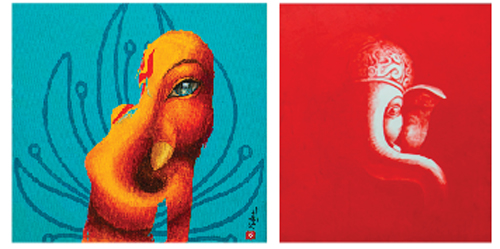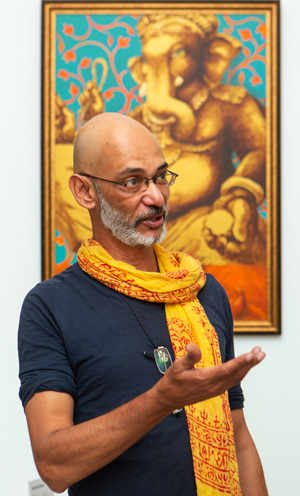Bonding with Lord Ganesh
 Talking with Mahen Chanmugam, you occasionally see flashes of the charming enfant terrible he had been – when his face breaks into a roguish smile after a gag, for example. But for the most part Lord Ganesh has converted, and made into an artistic hermit of sorts, the boy who was expelled from S. Thomas’ and Trinity respectively.
Talking with Mahen Chanmugam, you occasionally see flashes of the charming enfant terrible he had been – when his face breaks into a roguish smile after a gag, for example. But for the most part Lord Ganesh has converted, and made into an artistic hermit of sorts, the boy who was expelled from S. Thomas’ and Trinity respectively.
A gaunt, charismatic hermit with an aura- wreathed in cigarette smoke and moving with the grace of a yogi in his Nawala home, he is getting ready for the Galle Art Trail, where his art branded Ganeshism, his trademark, will be Number 1 in the trail, housed in the high-ceilinged Dutch colonial splendour of Amangalla Resort. The exhibition will be opened in the evening of January 15 and will go on till the 20th, when the FGLF and the Art Trail end.
Mahen, during the past 28 years, has not deviated from his single-minded focus on portrayals of Ganesh- rarely painting anything else. How did this Anglican- worldly, sophisticated and well-read- find such magnetic allure in Ganapathi?
The precise answer is locked with the mysteries of the cosmos. But Mahen remembers that his first toddler doodlings were always elephants. Growing up, his acts of rebellion at school stemmed from being forced to study conventional subjects while his heart was with an imaginative, creative world.

Mahen Chanmugam: Looking to Ganesh. Pix by Sameera Weerasekera
While working in brand development after quitting school early, he realized that the ‘world’s oldest brands were religions’. The ancient prescriptions of iconography are exact- like the identity guideline systems used for big corporates. And Ganesh, he says, is a very fluid brand as opposed to the more rigid identities of other divine beings. You could be creative with the wise yet jovial, human yet pachyderm deity who had been there from before Hinduism, going back to the Vedic age.
It marked the end of his unbridled living as the image of Ganesh spoke to him more and more. Mahen began by painting the more classical forms, kin to the kovil images. But with time his Ganesh would acquire a thousand maverick forms. All around his house, on canvas, antique doors, windows and boxes, Ganesh poses and cavorts in a hundred guises. There are nude female Ganeshas and a Ganesh in a black and blue jersey flashing peace signs, painted after the Bali bombing. They have a way of swimming into Mahen’s consciousness, though some of them he cannot interpret.
His spiritual metamorphosis can be seen in his paintings across time. While the early Ganeshas have a mystic, intimidating countenance and classic postures, the later Ganeshas seem to have descended from Kailash, with huge doe eyes that curdle with the milk of humane kindness. You feel the palpitating life, love and positive energy they emanate.
For Mahen religion is “the scourge of mankind”, yet his bond with Ganesh- as part of Vedic teaching which is not religion but a way of living- is deep. In the meditative state of painting the god, he has experienced a “strange, euphoric, elated feeling”, which he compares to an out of the body experience.
Mahen’s relationship with Ganesh has gone through many stages. At first he saw a god. Then his interest led him to Vedic studies and he saw Ganesh as a supreme position of the reality. Today Ganesh for him is the ‘root’ or muladhara chakra of Tantrism, the energy at the base of our spine that is also the home of the kundalini power.
For Mahen, his bond with Ganesh would never be that of the supplicant and favour-granting god.
Imbued in all his art is the core of Vedic teaching, where stress is laid on increasing your inner consciousness and awareness. The ultimate goal is being one with god- a metaphor for self realization.
In May last year Mahen closed down their company MCN Creative Associates. Today he explores the philosophical template that the elephant god is to him. His goal, of finding the divinity within himself, is symbolized in one of his most recurrent images: Ganesh, in all his splendour, painted within a gracefully poised yogi or yogini’s silhouette…


